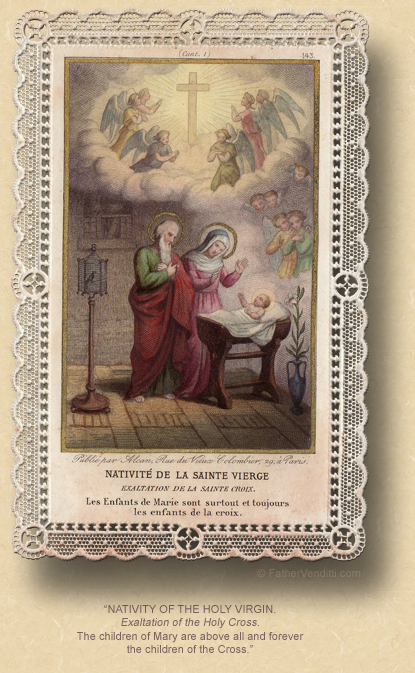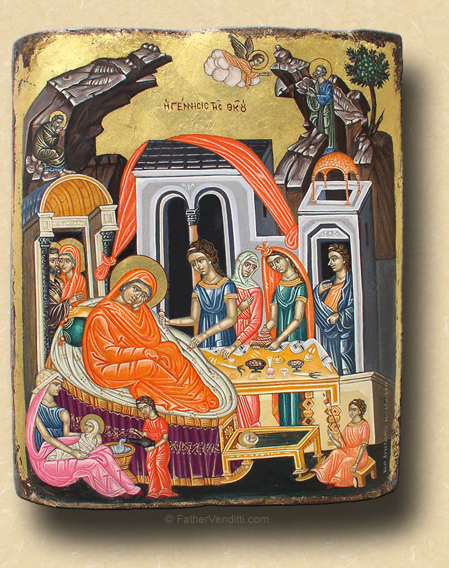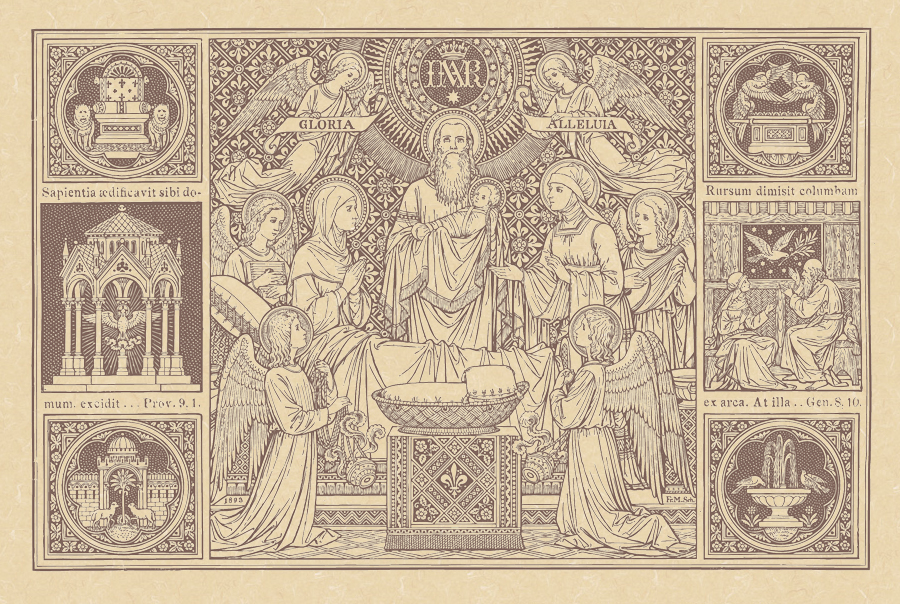Happy Birthday, Mom!
The Feast of the Nativity of the Blessed Virgin Mary.
Lessons from the proper, according to the ordinary form of the Roman Rite:
• Micah 5: 1-4.
[or, Romans 8: 28-30.]
• Psalm 13: 6.
• Matthew 1: 1-16, 18-23.
[or, Matthew 1: 18-23.]
The Second Class Feast of the Nativity of the Blessed Virgin Mary; and, the Commemoration of Saint Adrian, Martyr.*
Lessons from the proper, according to the extraordinary form of the Roman Rite:
• Proverbs 8: 22-35.
• [Gradual] Benedicta et venerábilis es…**
• Matthew 1: 1-16.
|
If a Mass for the commemoration is offered, lessons from the common "In virtúte…" for a Martyr not a Bishop:
• Wisdom 10: 10-14.
• Psalm 111: 1-2.
• Matthew 10: 34-42.
|
The Solemn Holy Day of the Birth of the Theotokos.
Lessons from the menaion, according to the Ruthenian recension of the Byzantine Rite:
• Phillipians 2: 5-11.
• Luke 10: 38-42; 11: 27-28.
FatherVenditti.com
|
 5:55 AM 9/8/2018 — Today, as you know, we celebrate the feast of the Nativity of the Mother of God, and I fear that we might miss the significance of it if we allow ourselves to regard it as simply another celebration of the Blessed Virgin; for, the Gospel lesson presented to us today is one of the most important presented to us by the Church all year. 5:55 AM 9/8/2018 — Today, as you know, we celebrate the feast of the Nativity of the Mother of God, and I fear that we might miss the significance of it if we allow ourselves to regard it as simply another celebration of the Blessed Virgin; for, the Gospel lesson presented to us today is one of the most important presented to us by the Church all year.
The Missal offers as an option a shorter version of this rather long Gospel lesson which skips all the odd-sounding Old Testament names, but it's actually the names of that genealogy which are important. There is a story in the Old Testament about every one of these people. And if we believe that the Gospel is the inspired word of God (which I’m sure we do), then God wants us to keep these names in mind. Matthew mentions them because he’s writing his Gospel to a primarily Hebrew audience; he wanted to show the Jews that Jesus was, in fact, the Messiah predicted in the Old Testament for the which the Hebrew people had been waiting. We read these names today because these names mean something just as important to us.
Break out your Old Testament and look up some of these people, and you’ll find that the human ancestors of our Lord were not all just and holy men. Among these names are sinners: those who committed incest, adultery, murder, apostasy; the names of Judas, of Thamar, of David and Ruth are filled with intrigue and calumny and horrific acts of despotism. Just take the one name of King David, who had a man named Uriah, a soldier of some distinction, sent to the front lines of a battle unprotected with the intention that he would be killed, because David lusted after this man’s wife. Saint Jerome, in his commentary on Matthew, points out that, among the women mention here, only the sinful ones are listed; the holy ones Matthew omits because he wants to show—and I'm quoting him here—“that He who came because of sinners, being born of sinful ancestors, should wipe out all sin.”*** These were the human ancestors of our Lord. Our Lord wanted men and women such as these as His human ancestors—that is the mystery of the Incarnation: He wanted, on the human level, to be linked with all the muck and mud of man.  He wanted to clear a way for Himself through the sins and crimes of humanity. After all, was that not the reason He came to earth as a man: to take upon His own back the sins of mankind? He wanted to clear a way for Himself through the sins and crimes of humanity. After all, was that not the reason He came to earth as a man: to take upon His own back the sins of mankind?
And here is where the genealogy of our Lord is significant for each of us; for it is the history of each one of us that He takes upon himself and overcomes. For each one of us has some of the features of our Lord’s less than sterling ancestors. In each one of us, either dormant or active, can be found the sins of the patriarchs and their children—there are never any new sins committed; only old sins with new faces. And just as Jesus once took upon Himself the flesh the Virgin Mary and came into this imperfect world in order to heal and save it, so He also comes into our flesh—in the Blessed Eucharist—to heal and save us.
The danger, of course, is that we make the same mistake that our Lord’s own people made in failing to recognize that He is, indeed, Who He claims to be. Saint Matthew, no doubt, thought that, by beginning his Gospel with our Lord’s human genealogy, everyone would be convinced: that Jesus fulfills everything that the prophets of the Old Testament required of the promised Messiah. He was wrong. They weren’t convinced. The question is: are we? Do we recognize that the Eucharist we celebrate and receive is our Lord, God and Savior, Jesus Christ? Do we realize that our own happiness, both in this world and the next, depends upon following Jesus Christ as perfectly as we can? Are we put off the idea of trying to follow Jesus perfectly with the excuse that we’re not holy? Many of our Lord’s own human ancestors were not holy; that was the whole point. As our Lord Himself said to the Pharisees who criticized his association with sinners, “It is not those who are in health that have need of the physician, it is those who are sick” (Mark 2: 17 Knox).

* Adrian suffered martyrdom with twenty-five others at Nicomedia under Emperors Diocletian and Maximian in 303.
The commemoration is made by an additional Collect, Secret and Postcommunion added to those of the feast, as a Mass for the commemoration is not ordinarily permitted on any day higher than a third class feast. However, some editions of the Missal of St. John XXIII indicate, for no stated reason, that a Mass for St. Adrian might be offered; it is presumed that it would not be the only Mass that day, and that the Mass for the feast is also being offered. It is also possible that the allowance for such a Mass is a misprint in these editions.
** The Gradual is non-Scriptural: "Blessed and venerable art Thou, O Virgin Mary: Who without blemish to Thy maidenhood, wert found to be the Mother of the Saviour. O Virgin, Mother of God, He Whom the whole world cannot contain, enclosed Himself in Thy womb and became Man."
*** Book 1 of Commentaries on Matthew, from Lesson vii of Matins in the Extraordinary Form of the Breviaruium Romanum.
|

